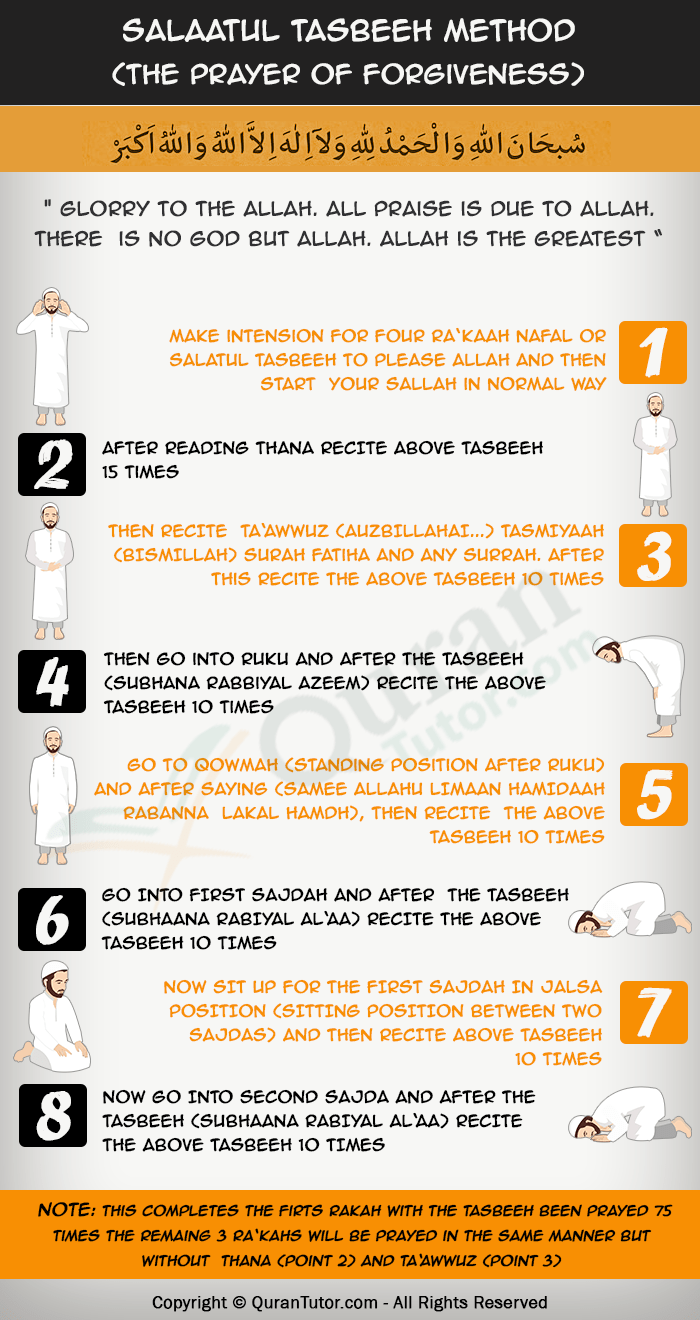How To Perform Salatul Tasbih (Prayer of Forgiveness)
Salah is one of the most important constituents of Muslim life and is the second pillar of Islam after Shahadah (belief in One Allah SWT and His Last Messenger ﷺ). Its basic aim is to communicate with the Almighty Lord, asking for His forgiveness and adopting the way of morality and uprightness. It is also a great means of supplication to the Gracious God for completion of one`s rightful wishes and desires.
Namaz is of two types: one is obligatory and the other is supererogatory in nature. The former is made compulsory on every believer to perform Salah five times a day at their specific times, i.e. Fajr (Morning), Dhuhur (Noon), Asr (Afternoon), Maghrib (Evening) and Isha (Night) prayers. On the other hand, the latter is the Sunnah (Way of Life) of the Holy Prophet ﷺ, Who used to offer prayers in His spare time which are known as Nafl (non compulsory) Salats. Some of such prayers are Tahiyatul Wudu, Tahajjud, Ishraq, Chaasht and Tasbeeh Salats etc.
Background And Importance Of Salaatul Tasbeeh
Tasbeeh is an Arabic whose literal meaning is “to Glorify Allah SWT”. It is actually a form Dhikr (remembrance of God) done by Muslims, which involves recurring phrases comprising of Adoration of the Almighty Lords. Hence, it is a practice involving praising of the Exalted One and showing one`s gratitude in front of Him.
Among all the Nafl prayers, the Salah of Tasbeeh holds a great distinction in terms of its remarkable importance in Muslim life. The Messenger ﷺ of God used to pray it and also regarded it highly beneficial for His followers to pray it in order to benefit from its huge implications resulting in one`s forgiveness of sins.
Rasulullah ﷺ is narrated to have said to his uncle Hazrat ‘Abbas (R.A):
O Abbas! O my uncle! Shall I not give you a gift? Shall I not show you something by means of which Allah will forgive your sins, the first and the last of them, the past and recent, the unintentional and the intentional, the small and huge, the secret and open? The Holy Prophet ﷺ then taught him the Salah al-Tasbih. Furthermore he advised him that it be offered daily, if possible. If not, then every Friday or once a month or once a year or at least once in one’s life time. (Abu Dawood)
According to the above mentioned Hadith, Hazrat Muhammad ﷺ, through guiding His own uncle, Hazrat Abbas (R.A), has awarded the whole Muslim community with a grand present of Salaatul Tasbeeh. This prayer encloses a method of pleasing the Most Merciful to grant believer mercy for its sins which have been committed in the past.

Number of Rakah, Timing and Tasbeeh
i) This prayer consists of 4 Rakaats in total which need to be carried out at a single time.
ii) As per the timing of this Salah is concerned, it can be performed at any time in day and night except for the Makrooh (forbidden) times of general prayers. It is advisable to definitely pray it during Shab e Qadar, as it is most auspicious night in the Religion of Islam.
iii) Tasbeeh included in this Namaz is as follows:
“Subhanallahi Wal Hamdulillahi Walaa Ilaaha Illallahu Wallahu Akbar”
(Glory is to Allah! And Praise is to Allah! There is no Deity to Worship except Allah and Allah is the Greatest)
This form of Veneration of Allah SWT needs to be recited 300 times in total by dividing into 75 times repetition during each Rakah of Salaatul Tasbeeh.
Steps to perform Salaatul Tasbeeh
Like any other Nafl Namaz, this prayer also requires following certain criterion which is discussed here:
- First of all, one has to make sincere Niyah (Intention) in front of Allah Almighty for carrying out of 4 Rakaats Nafl for Salaatul Tasbeeh and then start Salah in normal manner
- After reading the Thanaa or Sanaa (praising of the Creator of the universe), one needs to recite the above mentioned Tasbeeh 15 times before continuing Namaz
- Then comes the task of Ta`wwudh (A`udu billah) and Tasmiah (Bismillah). After that, Surah Fatiha followed by any Surah should be recited. Now, one has to read Tasbeeh again, but 10 times before going in to Ruku
- Reciting of Tasbeeh 10 times again after having said “Subhanna Rabbiyal ‘Adheem” should be done while being in the posture of Ruku (Leaning downwards)
- During Qayaam (Standing erect) posture, after reading normal “Sami’Allahu li man hamdidah Rabbana walakal-hamd”, recital of aforementioned Tasbeeh needs to be done 10 times
- While being in the state of Sajdah (Prostration), after reading regular “Subhaana Rabiyyal-’Ala”, one should recite the aforesaid Tasbeeh 10 times
- Repeating Tasbeeh 10 times again after having risen from Sajdah while sitting in the position of Iftirash
- Now, after having gone to execution of second Sajdah, one should read Tasbeeh 10 times again after reciting “Subhaana Rabiyyal-’Ala”
- Rest of three Rakaats will also follow the same pattern of recital of Tasbeeh with the exclusion of Sanaa and T`awwudh parts
Important Notes
- One should not count Tasbeeh in a loud voice, on its fingers or using beads.
- One can add up number of Tasbeeh recited in a specific situation by pressing its fingers one helping counting all 10 of them.
- If one of the Tasbeeh has been missed in any particular position, one can read it in next stance.
In short, Salaatul Tasbeeh is a great form of Nafl Namaz, which results in forgiveness and pardon over one`s past sins and wrongdoings by attaining the pleasure of Allah SWT by paying Him great Respect through Tasbeeh.









